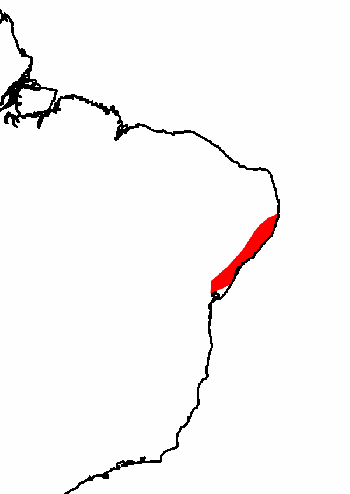(Attempt to disguise some copied text. Picture placement adjusted due to layout problems. References) |
|||
| Line 1: | Line 1: | ||
{{extinctwild}} | {{extinctwild}} | ||
| − | + | [[Image:Alagoas_Curassow.jpg|thumb|450px|right|Painting by {{user|Jose+Merizio+Jr|Jose Merizio Jr}}]] | |
;[[:Category:Mitu|Mitu]] mitu | ;[[:Category:Mitu|Mitu]] mitu | ||
| − | |||
==Identification== | ==Identification== | ||
| − | 89 cm | + | 89 cm<br /> |
| − | + | *Black glossed purplish blue plumage | |
| − | + | *Chestnut under-belly | |
| + | *Fourteen pale brown-tipped tail feathers | ||
| + | *Bare greyish crescent-shaped ear patch | ||
| + | *Whitish-tipped red bill | ||
| + | *Reddish brown iris<br /> | ||
| + | The female is slightly lighter than the male | ||
==Distribution== | ==Distribution== | ||
| − | Formerly resident in forests in the state of Alagoas, [[Brazil]], particularly around the Murici area. With most of the forest removed for the cultivation of sugarcane, the bird was thought to be extinct. A survey found a small number of birds and captured them for a zoo in Rio de Janeiro. With the continued destruction of the bird's habitat and the hunting pressure on cracids throughout Latin America, it seems unlikely that any wild birds survive | + | Formerly resident in forests in the state of Alagoas, [[Brazil]], particularly around the Murici area. With most of the forest removed for the cultivation of sugarcane, the bird was thought to be extinct. A survey found a small number of birds and captured them for a zoo in Rio de Janeiro. With the continued destruction of the bird's habitat and the hunting pressure on cracids throughout Latin America, it seems unlikely that any wild birds survive. |
| + | The species is now believed to be extinct in the wild. | ||
| + | [[Image:Alagoas_Curassow.png|thumb|350px|right| Former Range<br />Graphic by {{user|Nrg800|Nrg800}}]] | ||
==Taxonomy== | ==Taxonomy== | ||
| − | + | This is a [[Dictionary_M-S#M|monotypic]] species<sup>[[#References|[1]]]</sup>. | |
| − | |||
| − | |||
| − | |||
| − | |||
==Habitat== | ==Habitat== | ||
Forest. | Forest. | ||
==Behaviour== | ==Behaviour== | ||
| + | ====Diet==== | ||
The diet includes fruits. | The diet includes fruits. | ||
| + | ==References== | ||
| + | #{{Ref-Clements6thDec09}}#Wikipedia | ||
| + | {{ref}} | ||
==External Links== | ==External Links== | ||
{{GSearch|Mitu+Alagoas}} | {{GSearch|Mitu+Alagoas}} | ||
[[Category:Birds]] [[Category:Mitu]] [[Category:Artwork Only]] [[Category:Maps]] | [[Category:Birds]] [[Category:Mitu]] [[Category:Artwork Only]] [[Category:Maps]] | ||
Revision as of 13:54, 24 January 2010

|
The species Alagoas Curassow is extinct in the wild. |

|

- Mitu mitu
Identification
89 cm
- Black glossed purplish blue plumage
- Chestnut under-belly
- Fourteen pale brown-tipped tail feathers
- Bare greyish crescent-shaped ear patch
- Whitish-tipped red bill
- Reddish brown iris
The female is slightly lighter than the male
Distribution
Formerly resident in forests in the state of Alagoas, Brazil, particularly around the Murici area. With most of the forest removed for the cultivation of sugarcane, the bird was thought to be extinct. A survey found a small number of birds and captured them for a zoo in Rio de Janeiro. With the continued destruction of the bird's habitat and the hunting pressure on cracids throughout Latin America, it seems unlikely that any wild birds survive.
The species is now believed to be extinct in the wild.
Taxonomy
This is a monotypic species[1].
Habitat
Forest.
Behaviour
Diet
The diet includes fruits.
References
- Clements, JF. 2009. The Clements Checklist of Birds of the World. 6th ed., with updates to December 2009. Ithaca: Cornell Univ. Press. ISBN 978-0801445019.
- Wikipedia
Recommended Citation
- BirdForum Opus contributors. (2024) Alagoas Curassow. In: BirdForum, the forum for wild birds and birding. Retrieved 13 May 2024 from https://www.birdforum.net/opus/Alagoas_Curassow




